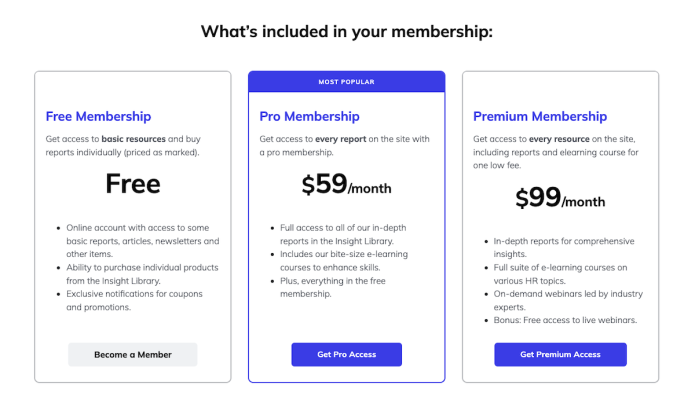
Building a subscription website allows you share your expertise and generate recurring revenue. Listed are the seven essential steps to help you build and launch a successful membership website, from conceptualisation, content creation, website development, usability, marketing and more.
1. Choose your subject niche
Choosing your website niche is a pivotal decision that sets the foundation for your online presence. It's essential to select a niche that aligns with your passion, expertise and the needs of your target audience.
By focusing on a specific niche, you can establish yourself as an authority on that subject, making it easier to attract and engage your audience. Research the market and competition within your chosen niche to identify gaps and opportunities that will allow you to stand out.
Consider the long-term viability of your niche and your ability to consistently create valuable content or products within it. A well-chosen niche can be the key to building a successful and sustainable online presence.
2. Decide on a membership website platform
Opting for a SaaS solution, like SubHub, when constructing your membership website offers many advantages. Firstly, SaaS platforms provide a user-friendly and intuitive interface, enabling even those with limited technical expertise to create and manage their membership sites efficiently.
SaaS solutions handle the hosting, security, and updates, alleviating you of the burden of technical maintenance and ensuring a secure online environment for your members.
With the scalability and flexibility inherent in SaaS, you can concentrate your energy on content creation and member engagement.
Always check customer reviews for the quality of customer support that the service delivers.
We do a cost and functionality comparison of the six top membership website builders.
3. Create content that meets the needs of your target audience
Content creation for a membership website is key to retaining and attracting members. It's crucial to regularly produce high-quality, exclusive content that consistently delivers value to your members.
Tailor your content to respond to the specific interests and needs of your target audience. Offer a diverse range of resources, including articles, videos, webinars, downloadable guides, and interactive discussions because people consume information in different ways.
Regularly update your content to keep it fresh and relevant. Consider member feedback as a valuable source of inspiration. Building a strong content library not only encourages member retention but also entices new subscribers, making it an integral component of your membership website's success.
4. Keep your subscription plans simple
A simple membership structure and pricing model reduces confusion. It makes it easier for potential members to understand the value they'll receive. When faced with too many choices, individuals may find it challenging to make decisions. They are more likely to be overwhelmed and abandon the site altogether.
To optimise the subscription process, create a pricing page that presents users with clear, concise choices that align with their needs and objectives. This approach can help streamline decision-making and increase sign ups.
Keeping your membership website simple is essential to ensure a positive user experience. Simplicity in design, navigation and content presentation reduces the learning curve for your members. A clutter-free interface helps members quickly and efficiently find the information or resources they're looking for. This will improve member satisfaction and retention.
5. Test the member experience
Testing the member experience is a crucial step before launching your subscription website. It ensures that your site functions seamlessly and delivers the intended value to your audience.
To thoroughly test the onboarding process, sign up as a member, navigate the site and access the content. Identify and rectify any technical glitches, navigation issues or content errors that might cause a negative user experience.
Pay close attention to mobile responsiveness and cross-browser compatibility, as members will be accessing your site from various devices.
A smooth member experience is pivotal to retaining subscribers, attracting new members and building a loyal audience.
6. Optimise for SEO
Search Engine Optimisation (SEO) plays a pivotal role in the successful launch of a membership website. By optimising your website's structure, content and keywords, you increase the chances of attracting targeted traffic.
- Conduct thorough keyword research: Identify the terms and phrases that your target audience is likely to use when searching for content related to your niche. Incorporate these keywords strategically into your website's content, headings, titles, meta descriptions and throughout your articles or posts.
- Ensure your site loads quickly: Confirm your site is mobile-friendly and has a clean and logical site structure.
- Publish high-quality, valuable content: Regularly update your website with fresh, relevant content that addresses the needs and interests of your target audience.
- Build high-quality backlinks: Guest posting, outreach to influencers and participating in relevant online communities can help you earn valuable backlinks that boost your site's authority.
- Monitor SEO with Google Search Console: Refine your SEO strategy based on data from Google Analytics and Google Search Console.
7. Develop a marketing strategy
Attracting potential members takes effort. Begin by understanding your target audience, their pain points, and their online behaviors.
Post on the social media channel where your audience spends their time. Craft content that not only showcases your expertise but addresses the specific needs of your potential members.
Consider offering special promotions or incentives to encourage early sign-ups and word-of-mouth referrals. Your marketing strategy should be tailored to your membership website's niche and speak directly to your target audience.
In conclusion
Remember that launching a membership website is an ongoing process. You'll need to adapt and evolve your site based on member feedback and changing trends to keep it successful and sustainable over time.




